Turn Off Spanning Tree Portfast. Message Edited by anonimous on 12-28-2005 0912 AM. If it receives BPDU It will disable the Spanning tree from this port. A common misunderstanding among Cisco students is that portfast disables spanning-tree on a certain interface. Although it is not recommended you can turn off Spanning Tree Protocol STP on a per-VLAN basis or globally on the switch.
 How To Configure Portfast On Cisco Switch Step By Step From protechgurus.com
How To Configure Portfast On Cisco Switch Step By Step From protechgurus.com
Conditional on Portfast state. Use the no spanning-tree vlan vlan-id command in order to disable STP on a per virtual LAN VLAN basis. So I still dont think its correct to say that its disabling STP. In order to optimize the port configuration the set port host command sets the channel mode to off enables spanning tree PortFast sets the trunk mode to off and disables the IEEE 8021Q dot1q tunnel feature. Dont do this for links to switches - they should be set up as part of your spanning tree. Portfast is related to spanning tree and basically turns it off on the port enabling the port to come up and be active immediately instead of taking a second or so to negotiate and listen on the port to see what its connected to.
Normal Spanning Tree Protocol STP convergence Layer 2 convergence time is 50 seconds and the end user traffic is blocked until Root Port andor Designated Port reach the forwarding state.
Verify Spanning Tree Settings. Author teacher and talk show host Robert McMillen shows you how to how to turn off spanning tree portfast on a Cisco switch port. I would think turning off spanning-tree would be more likely to cause a time out than having it on. Although it is not recommended you can turn off Spanning Tree Protocol STP on a per-VLAN basis or globally on the switch. To completely disable spanning tree we. Filters all incoming and all out going BPDUs.
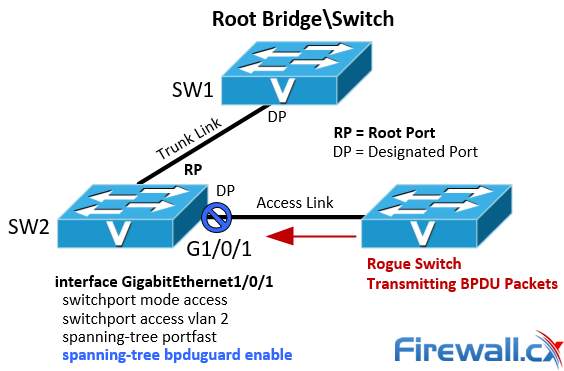 Source: firewall.cx
Source: firewall.cx
PortFast and BPDU Guard. If it receives BPDU It will disable the Spanning tree from this port. Vty-0config-if doesnt work. I would think turning off spanning-tree would be more likely to cause a time out than having it on. We can use the feature called Spanning Tree.
 Source: slidetodoc.com
Source: slidetodoc.com
We can use the feature called Spanning Tree. Console show spanning-tree. The following section describes some of the Layer-2 Spanning Tree Protocol STP features for the branch controller solution. Command spanning-tree disable Vty-0configinterface ethernet 11 Vty-0config-ifspanning-tree disable Invalid input detected at marker. Dont do this for links to switches - they should be set up as part of your spanning tree.

A port configured with portfast skips the listening and learning phases of the spanning-tree protocol and the port transitions directly to the forwarding state. So I still dont think its correct to say that its disabling STP. To completely disable spanning tree we. Use the no spanning-tree vlan vlan-id. Portfast should only be used on connections to end devices.
 Source: certificationkits.com
Source: certificationkits.com
Use the no spanning-tree vlan vlan-id. Howto disable Spanning Tree on some ports from PowerConnect 5224. Conditional on Portfast state. Locally per-port configured BPDU Filter. With that said its best practice to enable BPDU guard or filter to immediately shut that port down if a loop does occur.
 Source: networklessons.com
Source: networklessons.com
Locally per-port configured BPDU Filter. By default interfaces on routers are administratively shut down. Once the port is up the behavior is to send BPDUs and disable Portfast if BPDUs are received. I know it has to be on for bootp boot devices to work. Console show spanning-tree.
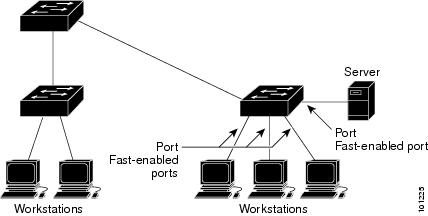 Source: content.cisco.com
Source: content.cisco.com
When you enable BPDU guard on the switch spanning tree shuts down PortFast-configured interfaces that receive BPDUs instead of putting them into the spanning tree blocking state. Command spanning-tree disable Vty-0configinterface ethernet 11 Vty-0config-ifspanning-tree disable Invalid input detected at marker. Author teacher and talk show host Robert McMillen shows you how to how to turn off spanning tree portfast on a Cisco switch port. With that said its best practice to enable BPDU guard or filter to immediately shut that port down if a loop does occur. Hello on ports connected to other switches turn portfast off on user ports turn it on.
 Source: tp-link.com
Source: tp-link.com
Normal Spanning Tree Protocol STP convergence Layer 2 convergence time is 50 seconds and the end user traffic is blocked until Root Port andor Designated Port reach the forwarding state. In your setup the Juniper stack w RSTP provides protection from loops. Console show spanning-tree. So I still dont think its correct to say that its disabling STP. The spanning tree feature cannot be turned off in switches on a per port basis.
 Source: certificationkits.com
Source: certificationkits.com
0 ROOT ID Priority 32768 Address D067E5A57FC5 This Switch is the Root. 8000D067E5A57FC5 Regional Root Path Cost. Portfast should only be used on connections to end devices. Enable FastEthernet00 which is connected to Fa01 then observe the switches spanning-tree behavior via the show spanning-tree command. Once the port is up the behavior is to send BPDUs and disable Portfast if BPDUs are received.
 Source: flackbox.com
Source: flackbox.com
This is not correct howeverif you enable portfast on an interface then it will jump to the forwarding state of spanning-tree. Portfast should only be used on connections to end devices. 8000D067E5A57FC5 Regional Root Path Cost. Also the root bridge is the one that traffic always flows over between branches. If you connect hubs concentrators switches and bridges to a fast.
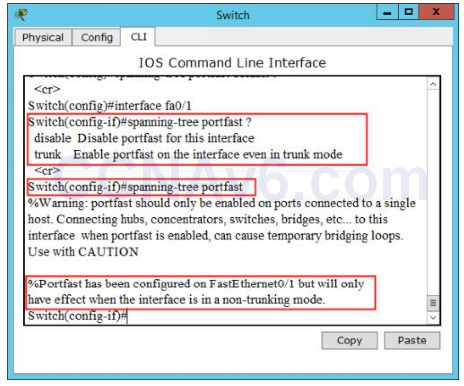 Source: itexamanswers.net
Source: itexamanswers.net
If you want to stop the underlying cause make sure all ports where a single device is connected are set up with spanning-tree portfast for access ports or spanning-tree portfast trunk for trunk ports. A common misunderstanding among Cisco students is that portfast disables spanning-tree on a certain interface. I am unfamiliar with KACE and can be of no help there but I dont see how having spanning-tree on could cause a time out it is there specifically so you dont get time outs. How to DisableEnable Spanning Tree Protocol Per Switch Port. 8000D067E5A57FC5 Regional Root Path Cost.
 Source: slidetodoc.com
Source: slidetodoc.com
Normal Spanning Tree Protocol STP convergence Layer 2 convergence time is 50 seconds and the end user traffic is blocked until Root Port andor Designated Port reach the forwarding state. Equivalent of turning off STP on the port. Portfast should only be used on connections to end devices. Verify Spanning Tree Settings. Filters most of outgoing BPDUs.
 Source: networkengineering.stackexchange.com
Source: networkengineering.stackexchange.com
Command spanning-tree disable Vty-0configinterface ethernet 11 Vty-0config-ifspanning-tree disable Invalid input detected at marker. Spanning Tree Protocol STP convergence Layer 2 convergence happens when bridges and switches have transitioned to either the forwarding or blocking state. So I still dont think its correct to say that its disabling STP. The only reason I know of to turn off STP is on access ports for hosts so they come up immediately. A common misunderstanding among Cisco students is that portfast disables spanning-tree on a certain interface.
 Source: youtube.com
Source: youtube.com
The spanning tree feature cannot be turned off in switches on a per port basis. Vty-0config-if doesnt work. Use the no spanning-tree vlan vlan-id command in order to disable STP on a per virtual LAN VLAN basis. Use the no spanning-tree vlan vlan-id command in order to. I would think turning off spanning-tree would be more likely to cause a time out than having it on.
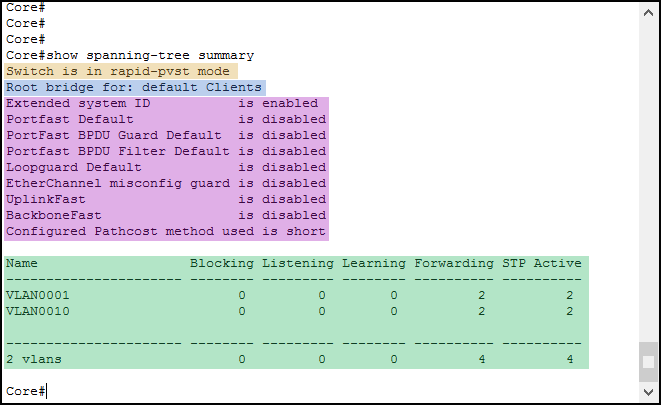 Source: warriorfasr985.weebly.com
Source: warriorfasr985.weebly.com
When you enable BPDU guard on the switch spanning tree shuts down PortFast-configured interfaces that receive BPDUs instead of putting them into the spanning tree blocking state. With that said its best practice to enable BPDU guard or filter to immediately shut that port down if a loop does occur. Normal Spanning Tree Protocol STP convergence Layer 2 convergence time is 50 seconds and the end user traffic is blocked until Root Port andor Designated Port reach the forwarding state. Equivalent of turning off STP on the port. Use the no spanning-tree vlan vlan-id.
 Source: blog.ternet.or.tz
Source: blog.ternet.or.tz
I know it has to be on for bootp boot devices to work. Use the no spanning-tree vlan vlan-id command in order to disable STP on a per virtual LAN VLAN basis. Once the port is up the behavior is to send BPDUs and disable Portfast if BPDUs are received. Locally per-port configured BPDU Filter. Author teacher and talk show host Robert McMillen shows you how to how to turn off spanning tree portfast on a Cisco switch port.
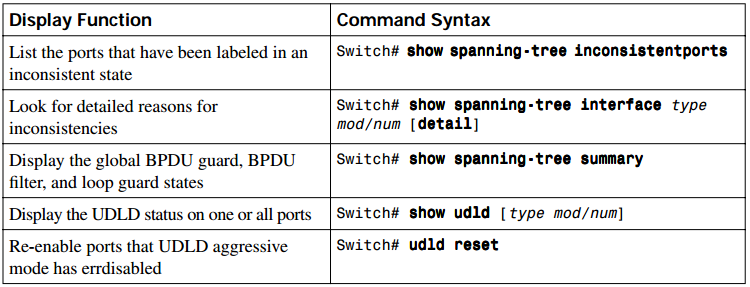 Source: configrouter.com
Source: configrouter.com
Filters all incoming and all out going BPDUs. With that said its best practice to enable BPDU guard or filter to immediately shut that port down if a loop does occur. If you want to stop the underlying cause make sure all ports where a single device is connected are set up with spanning-tree portfast for access ports or spanning-tree portfast trunk for trunk ports. PortFast and BPDU Guard. PortFast BPDU guard prevents loops by moving a nontrunking port into an errdisable state when a BPDU is received on that port.
 Source: ipwithease.com
Source: ipwithease.com
Author teacher and talk show host Robert McMillen shows you how to how to turn off spanning tree portfast on a Cisco switch port. Although it is not recommended you can turn off Spanning Tree Protocol STP on a per-VLAN basis or globally on the switch. Here is the explanation. So I still dont think its correct to say that its disabling STP. We can use the feature called Spanning Tree.
 Source: zartmann.dk
Source: zartmann.dk
If you connect hubs concentrators switches and bridges to a fast. By default interfaces on routers are administratively shut down. Although it is not recommended you can turn off Spanning Tree Protocol STP on a per-VLAN basis or globally on the switch. The only reason I know of to turn off STP is on access ports for hosts so they come up immediately. Use the no spanning-tree vlan vlan-id command in order to disable STP on a per virtual LAN VLAN basis.






